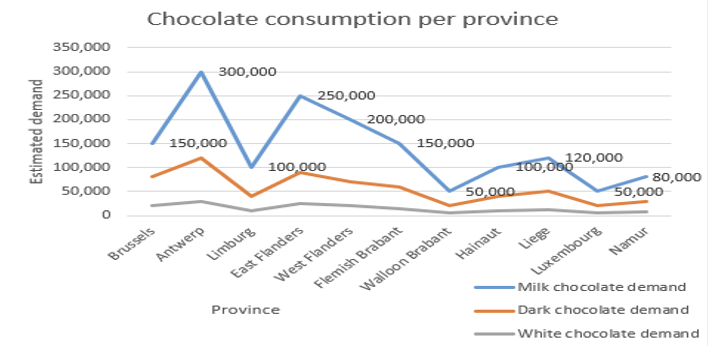Chocolate Market Proposal and Demand Estimation in Belgium
The table below compares the factors that influence the domestic market for chocolate in the United States and Belgium (Alberts & Cidell, 2020), using the five concepts of object, objective, occurrence, outlet, and opposition.
| Concepts | United States Market Factors | Belgian Market Factors |
| Object | Chocolate is a popular confectionery item consumed as a snack or dessert and is available in various forms such as. Generally, sweeter with a creamier texture due high sugar content but low cocoa content | Chocolate is not only a popular sweet treat but also a cultural icon. Belgium produces high-quality chocolates with high cocoa content but low sugar content, with a focus on using fine ingredients and traditional production methods. |
| Objective | The primary motivation for buying chocolate is enjoyment, with a focus on taste and convenience. | Chocolate is often associated with gift-giving and special occasions, such as birthdays and holidays. |
| Occurrence | Chocolate is consumed at various times throughout the day and on the go. Chocolate is also commonly used as an ingredient in baking and desserts. | Chocolate is often consumed as an indulgent treat in the afternoon or after dinner. It may also be consumed as a dessert or snack after a meal. |
| Outlet | Chocolate is widely available in a variety of retail outlets, including supermarkets, gas stations, convenience stores. It can also be purchased online. | Chocolate is primarily sold in specialty shops, department stores, and patisseries. It can also be purchased directly online. |
| Opposition | Chocolate faces competition from a wide range of confectionery items, including candy, cookies, and ice cream. Consumers may also choose to purchase lower-priced, lower-quality chocolate products. | Chocolate faces competition from other high-quality chocolate brands, as well as premium sweets and desserts. Belgian consumers are generally discerning and may be willing to pay more for premium chocolate product |
Introduction
Belgium is known for its high-quality chocolate and is considered a major producer of chocolate in the world. The country has a long-standing tradition of producing chocolate, dating back to the 19th century. The Belgian population is known to be among the highest consumers of chocolate in the world, with an average per capita consumption of around 8 kg per year (Alberts & Cidell, 2020). The purpose of this proposal is to estimate the demand for chocolates in Belgium by province and type of chocolate and illustrate how to position the product in the market for effective competition.
Struggling with your marketing proposals or chocolate market assignments? Our experts provide human-written market proposal and demand estimation assistance, guiding you through product positioning, regional trends, and consumer behavior analysis. Every submission comes with plagiarism and AI reports for authenticity. Make your coursework stand out with our professional marketing assignment support and confidently submit high-quality, academically sound work.
Data analysis
The following key product characteristics should be considered so as to effectively position our product versus competition;
Quality of the product: Belgians always emphasize on the quality of chocolate. Therefore, our product should be positioned as a premium chocolate brand with superior taste and quality compared to the competition (Užar & Radojević, 2020). This can be achieved by using high-quality ingredients, highlighting the artisanal production process, and showcasing any certifications or awards that the product has received. The central focus of the brand’s positioning, as this will help to differentiate it from the competition.
Unique flavours and varieties: Our product should be positioned as a brand that offers a wide variety of unique and innovative flavours that are not available from the competition (Užar & Radojević, 2020). This can be achieved by introducing new flavours and varieties regularly and promoting them through targeted marketing campaigns. The brand should stand out from the competition and appeal to a wide range of customers.
Apart from the key characteristics, there are several other variables that may affect the demand for our product in the Belgian market. Some of these variables are:
The state of the economy: Belgians consider chocolate as a luxury item and therefore, during times of economic uncertainty, consumers tend to reduce their spending on luxury items such as chocolates.
Seasonal variations: chocolate consumption in Belgium is often associated with specific occasions, such as holidays or special events. The demand for chocolates therefore will be higher during festive seasons such as Christmas, Easter, and Valentine’s Day.
Health and wellness trends: The increasing awareness of health and wellness may affect the demand for chocolates, especially those with high sugar and fat content. Companies offering healthier chocolates, therefore, has a higher competitive advantage.
Availability and accessibility: The availability and accessibility of our product in different regions may affect the demand (Kotler, 2022). The wider availability and accessibility of chocolate products can lead to higher consumption levels, while limited availability or high prices may lead to lower consumption levels.
Demographic factors: Age, income, and education level can all impact chocolate consumption (Kotler, 2022). For example, younger consumers may be more interested in trendy flavours and packaging, while older consumers may be more interested in traditional flavours and higher quality chocolate.
The statistics provided in the table below are estimates of the demand for different types of chocolate (milk, dark, and white) in the different provinces of Belgium. To estimate the potential demand for the product, we have used regression analysis with the two key characteristics as independent variables and the estimated demand as the dependent variable.
The equation for the multiple regression model would be of the form:
The estimated Demand = β0 + β1(Premium Quality) + β2(Unique flavours) + ε where β0 is the intercept, β1 and β2 are the coefficients for the independent variables, and ε is the error term.
The demand for the product was also estimated using population data, income levels, and market research in addition to the key characteristics. Population data was used to estimate the size of the market in each province, while income levels were used to estimate the willingness to pay for high-quality chocolate. The regression analysis considers the Belgian population by province and type of chocolate. The results of the analysis are summarized in the following table:
|
The data above are illustrated in the graph below

Conclusion
The chocolate demand varies between the different provinces due to different population sizes and the income level of each province. Therefore, we can use regression analysis to estimate chocolate demand by province and type in Belgium. Positioning our product uniquely, we can differentiate ourselves from the competition and appeal to customers who value traditional and authentic chocolates or those looking for a unique taste experience.
References
Alberts, H. C., & Cidell, J. L. (2020). Chocolate Consumption, Manufacturing and Quality. Journal of Food Science and Technology (JFST) Food Science.
Kotler, P. (2022). Marketing management: Analysis, planning and control. Prentice Hall.
Užar, D., & Radojević, V. (2020). The Marketing Concept of Agricultural Holdings: The Case of Serbian Cheese. Contemporary Agriculrure.

